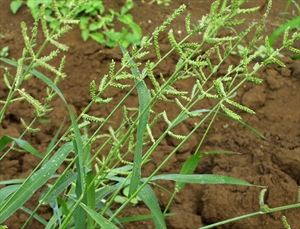Jungle rice; it is also known as barnyard grass, or awnless barnyard grass. CABI prefers the name junglerice; there are several grass species with the name barnyard grass, including Echinochloa crus-galli.
Pacific Pests, Pathogens, Weeds & Pesticides - Online edition
Pacific Pests, Pathogens, Weeds & Pesticides
Jungle rice (454)
Echinochloa colona. It was known previously as Panicum colonum. It is a member of the Poaceae.
Asia, Africa, North, South and Central America, the Caribbean, Europe, Oceania. It is recorded from Australia, American Samoa, Cook Islands, Federated States of Micronesia, Fiji, French Polynesia, Guam, Marshall Islands, Nauru, New Caledonia, Niue, Palau, Papua New Guinea, Samoa, Solomon Islands, Tonga, Vanuatu, and Wallis & Futuna.
The origin of jungle rice is unknown; it is widely naturalised throughout the tropics, sub-tropics and warmer temperate regions of the world.
One of the most troublesome annual weeds of the tropics, commonly invasive in crops (upland and irrigated rice, maize and vegetables), gardens, disturbed sites, waste areas and pastures, and along roadsides. Invasive in natural areas: along waterways, on the margins of lakes and ponds, in swamps and wetlands, and in other damp habitats. Mostly in coastal areas that are seasonally rather than permanently flooded, but extending to 2000 masl. Prefers, moist, heavy, fertile soils, sunny locations or those with light shade.
An annual, shallow-rooted grass, erect or growing along the ground, with reddish-purple stems, often branched from the base, 20-60 cm tall. Leaf blades, flat, usually hairless on the upper surface, up to 22 cm long, sometimes with purplish banding. These purple bands are characteristic, distinguishing it from other grasses, e.g., barnyardgrass, Echinochloa crus-galii. Stems are hairless except at the stem joints (nodes). There is no ligule (a flap or strap-like outgrowth on the inner side of the leaf sheath at its junction with the leaf). Flowerheads up to 15 cm long, with 5-10 widely-spaced flower groups (spikelets) (Photo 1). These spikelets are about 2.5 cm long, and have flowers arranged in several rows along a central spine. There is no bristle at the end of the spikelets (as in barnyard grass).
Spread over short distances is through stems coming in contact with the soil, rooting and establishing new shoots. Cut portions of the lower parts can regenerate too. Long-distance spread is by seeds (Photo 2), spread by the wind, in irrigation water, and by animals. Spread also occurs when grass with seed is moved as animal feed. Jungle rice is a contaminant of rice seed.
Impacts from jungle grass can be substantial. Yield reductions are due to rapid growth, large infestations and aggressiveness. It is a common weeds of rice, maize, cotton, mungbean, Phaseolus been, and taro. In rice, yield losses range from 25-60%, more in upland rice where jungle rice is often the most dominant weed.
Jungle rice causes environmental impacts, by invading and outcompete native vegetation. In Australia, the USA, and South and Central America, it is ranked among the top environmental weeds. In Australia, this species has invaded wetter habitats, including endangered swamp tea tree (Melaleuca tamariscina subsp. irbyana) thickets.
The seeds can be ground into a flour and used as a porridge.
AUTHORS Grahame Jackson & Aradhana Deesh
Adapted from Awnless barnyard grass (Echinochloa colona) (2018) Weeds of SE Qld and Northern NSW. Lucidcentral. (https://www.lucidcentral.org/editors-pick-animal-and-plant-identification-keys/key-to-weeds-of-se-qld-and-northern-nsw); and additional information from CABI (2019) Echinochloa colona (jungle rice). Invasive Species Compendium. (https://www.cabi.org/isc/datasheet/20368); and from Junglerice (Echinochloa colona) (2019) UC/IPM. Agriculture & Natural Resources. University of California. (http://ipm.ucanr.edu/PMG/WEEDS/junglerice.html). Photo 2 Tauʻolunga_Echinochloa_colona. Photo 3 D. Walters and C. Southwick, Table Grape Weed Disseminule ID, USDA APHIS PPQ, Bugwood.org.
Produced with support from the Australian Centre for International Agricultural Research under project HORT/2016/185: Responding to emerging pest and disease threats to horticulture in the Pacific islands, implemented by the University of Queensland, in association with the Pacific Community and Koronivia Research Station, Ministry of Agriculture, Fiji.





